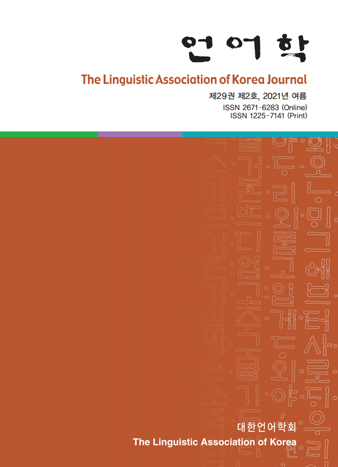대한언어학회 전자저널

29권 2호 (2021년 6월)
- 딥러닝 기반 단어 임베딩을 적용한 사진 자막 영작문 채점 시스템
-
김동성
Pages : 1-20
Abstract
Kim, Dongsung. (2021). Automatic scoring system for picture-based English caption writing test adopting deep learning based word-embedding. The Linguistic Association of Korea Journal, 29(2), 1-20. Since human grading of English writing requires substantial resources, many researchers in the area of Computer-Assisted Language Learning (CALL) have been focusing on automatic scoring systems based on natural language processing systems, machine learning, and other automatic processing mechanisms. English Testing Services (ETS) announced several automatic scoring systems for English writing. In this paper, we suggest using a deep learning based automatic scoring system for an English caption writing test. Our method involves using a sentence similarity measurement, which compares different levels of answer sentences with user writing input. We chose different word embedding types (Word2Vec, Word Movers Distance (WMD), Bidirectional Encoder Representations from Transformers (BERT)) and Abstract Meaning Representation (AMR), a linguistic model for comparing semantic differences between two sentences based on semantic representation. Scoring systems should not only satisfy the requirements of complicated scoring rubrics but also meet the conditions of a language proficiency test. Our results show that BERT outperforms three competitive models in predicting accurate scoring levels and also shows the characteristics of the criterion reference which could theoretically express the standards of a language proficiency test.
Keywords
# 컴퓨터 언어보조학습(computer assisted language learning) # 딥러닝(deep learning) # 영작문(English writing) # 단어 임베딩 (word embedding) # 준거참조검사(criterion-referenced test) # 채점(scoring)
References
- 김동성, 채희락, 이상철. (2008). 문법성과 어휘 응집성 기반의 영어 작문 평가 시스템. 인지과학, 19(3), 223-255.
- 김동성. (2016). 추상적 의미 표상을 활용한 사진 자막 영작문 평가. 언어학, 24(4), 1-26.
- 김지은, 이공주. (2007). 중학생 영작문 실력 향상을 위한 자동 문법 채점 시스템 구축. 한국콘텐츠학회논문지, 7(5), 36-46.
- 민선식. (2008). Toeic Writing Test 공식문제집. 서울: 시사영어사.
- 진경애. (2007). 영작문 자동 채점 시스템 개발 연구. 영어어문교육, 13(1), 235-259.
- Attali, Y., & Burstein, J. (2006). Automated essay scoring with e-rator V.2. Journal of Technology, Journal of Learning, and Assessment, 4(3), 3-30.
- Botvin, G., & Sutton, S. (1977). The development of structural complexity in children’s fantasy narratives. Developmental Psychology, 13(4), 377–388.
- Cai, S., & Knight, K. (2013). Smatch: an evaluation metric for semantic feature structures. In Proceedings of the ACL, 748-752.
- Cohen, C., Higham, C., & Nabi, S. (2020). Deep learnability. Frontiers in AI, 3(43), 1-11.
- Condon, W. (2009). Looking beyond judging and ranking. Assessing Writing, 14(3), 141-56.
- Dalad, N., & Manoj, N. (2018). Transforming second language acquisition modeling. In Proceedings of NIPS, 1-9.
- Farouk, M. (2019). Measuring sentence similarity. Indian Journal of Science and Technology, 12(25), 1-11.
- Firth, J. (1957). Papers in Linguistics 1934–1951 (1957) London: Oxford University Press.
- Goldberg, Y. (2019). Assessing BERT’s syntactic abilities. arXiv:1901.05287.
- Heift, T., & Schulze M. (2007). Errors and Intelligence in Computer-Assisted Language Learning. New York: Routledge.
- Jawahr, G., Benoit, S., & Seddah, D. (2019). What does BERT learn about the structure of language? In Proceedings of ACL, 3651-3657.
- Jurafsky, D., & Martin, J. (2020). Speech and language processing. London, UK: Pearson.
- Kusner, M., Sun, S., Klkin N., & Weinberger, K. (2015). From word embeddings to document distance. In Proceedings of International Conference on Machine Learning, 957-66.
- Leacock, C., & Chodorow, M. (2003). C-rater. Computers and Humanities, 37, 389-405.
- Leacock, C., Chodorow, M., Gamon, M., & Tetreault, J. (2014). Automated Grammatical Error Detection for Language Learners. San Rafael, CA: Morgan & Claypool Publishers.
- Manning, C. (2017). Representations for Language. Retrieved January 26, 2021, from http://simons.berkeley.edu/sites/default/files/docs/6449/christo phermanning.pdf.
- McKeough, A., & Malcolm, J. (2011). Stories of family, stories of self: Developmental pathways to interpretive thought during adolescence. New Directions for Child & Adolescent Development, 2011(131), 59-71.
- Mikolov, T., Sutskever, I., Chen, K., Corrado, G., & Dean, J. (2013). Distributed representations of words and phrases and their compositionality. In Proceedings of NIPS, 3111-9.
- Nagata, N. (1996). Computer vs. Workbook instruction in second language acquisition. CALICO Journal, 14(1), 53–75.
- Ramasinghe, T., Orasan, S., & Mitkov, R. (2019). Enhancing unsupervised sentence similarity methods with deep contextualized word representation. In Proceedings of the Recent Advances in NLP, 994-1003.
- Rivers, W. (1981). Teaching foreign-language skills. Chicago: Univ. of Chicago Press.
- Somasundaran, S., Lee, C., Chodorow, M., & Wang, X. (2015). Automated scoring of picture-based story narration. In Proceedings of Innovative Use of NLP for Building Educational Applications, 42–48.
- Settles, B., LaFlair, G., & Hagiwara, M. (2020). Machine learning-driven language asessment. In Proceedings of the Transactions for Computational Linguistics, 247-263.
- Sukkarieh, J., & Stoyanchev, S. (2009). Automating model building in c-rater. In Proceedings of Applied Textual Inference, 61-69.
- Turc, I., Chang, M., Lee, K., & Toutanova, K. (2019). Well-read students learn better: On the importance of pre-training compact models. Unpublished manuscript.
- Warstadt, A., & Bowman, S. (2020). Can neural networks acquire a structural bias from raw linguistic data? In Proceedings of Cognitive Science Society, 1737-1943.
- Weigle, S. (2010). Validation of automated scores of TOEFL iBT tasks against non-test indicators of writing ability. Language Testing, 27(3), 335–353.
- Weigle, S. (2011). Validation of automated scores of TOEFL iBT tasks against non-test indicators of writing ability. TOEFL iBT Research Report TOEFL iBT-15. Princeton, NJ: Educational Testing Service.
- Wiegle, S. (2013). English as a second language writing and automated essay evaluation. In M. Shermis & J. Burstein (Eds.), Handbook of automated essay evaluation (pp. 36-54). New York: Routledge.